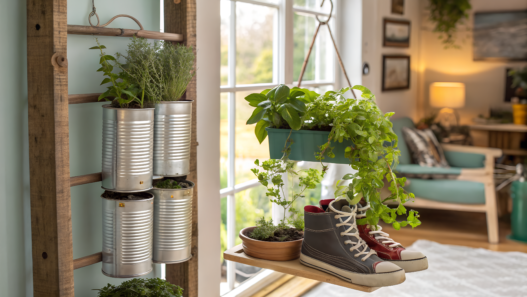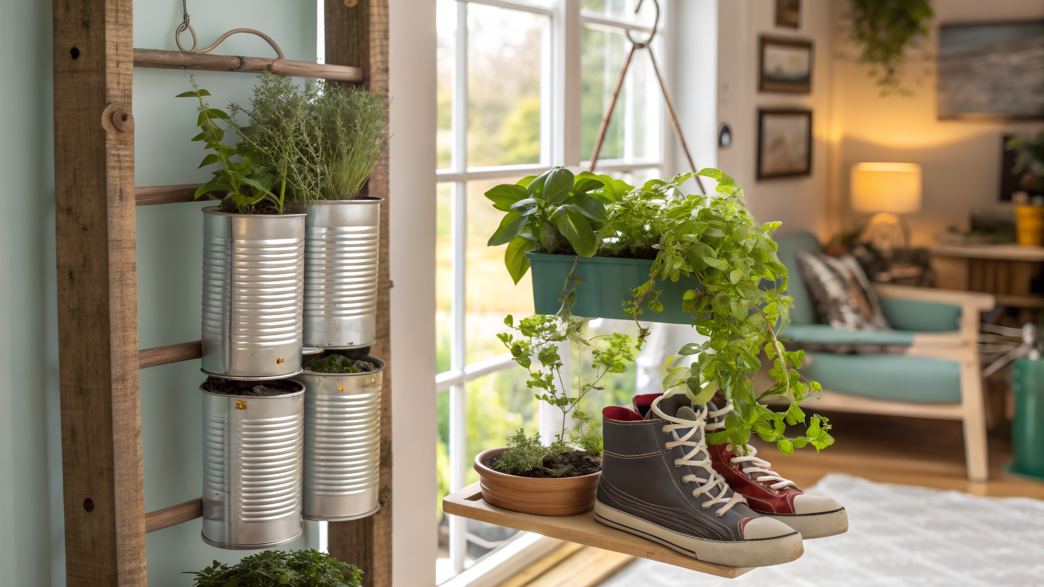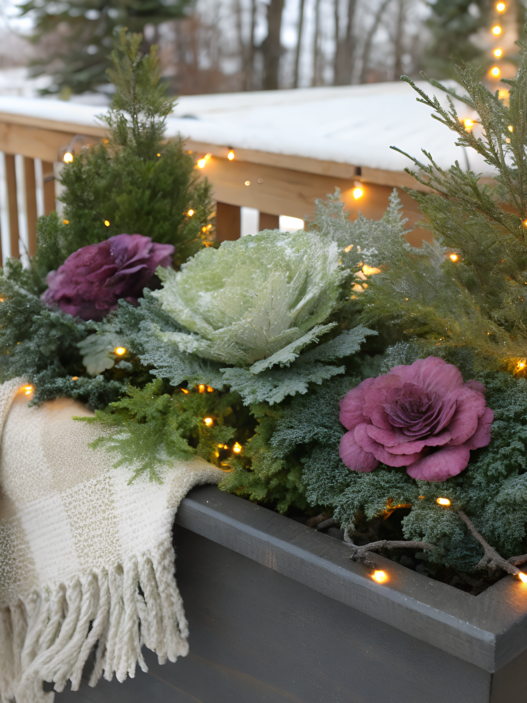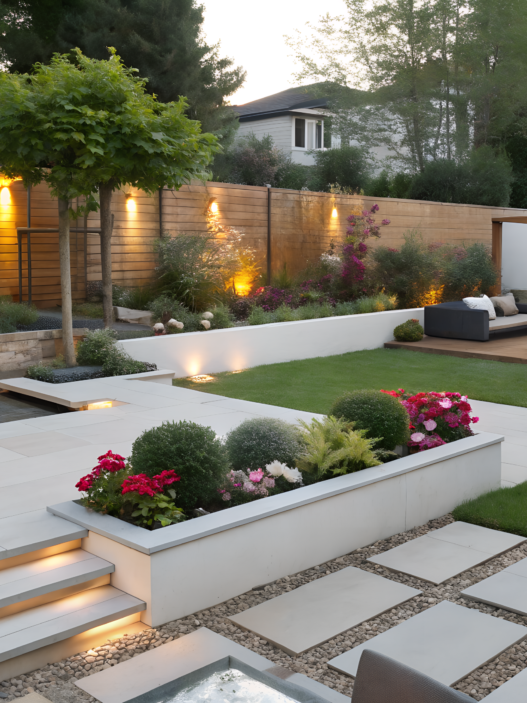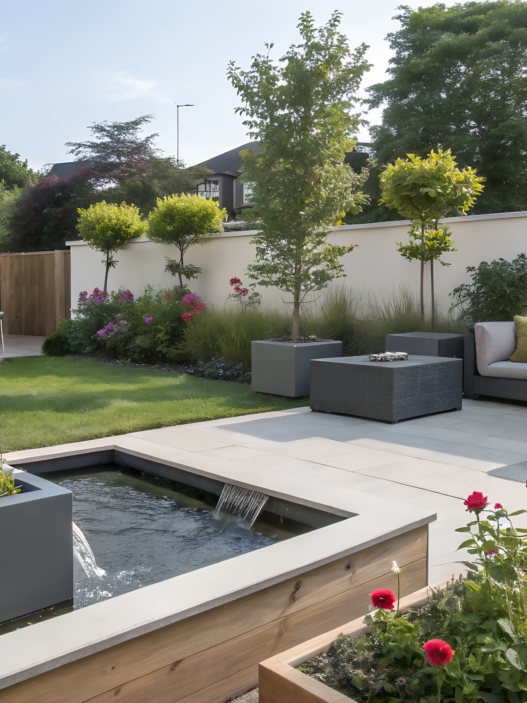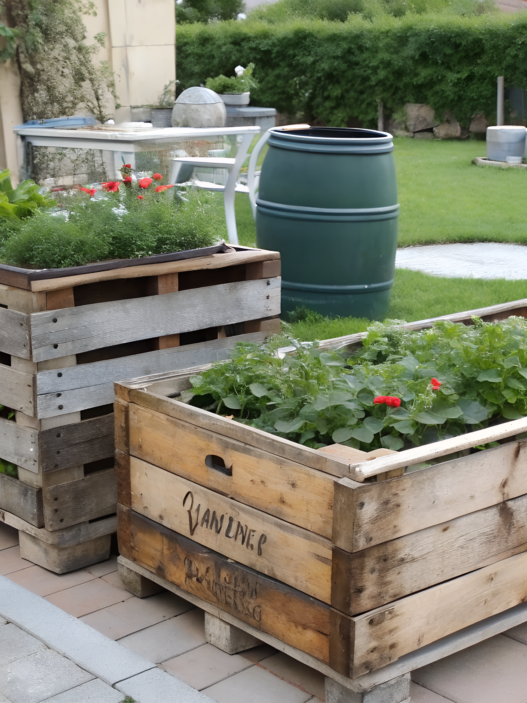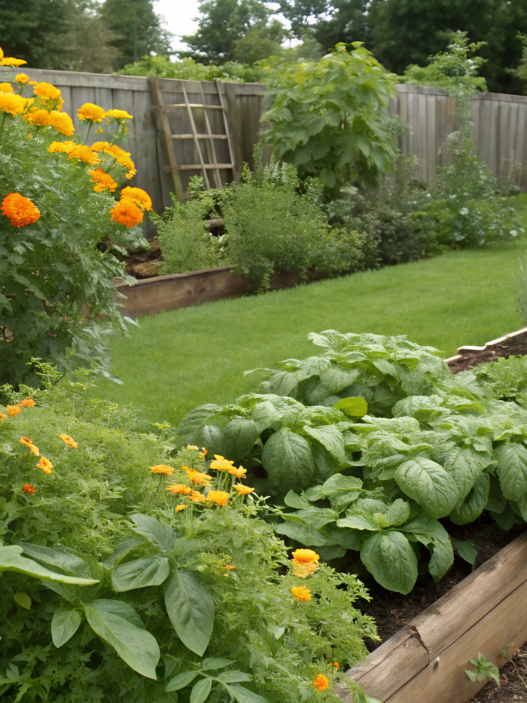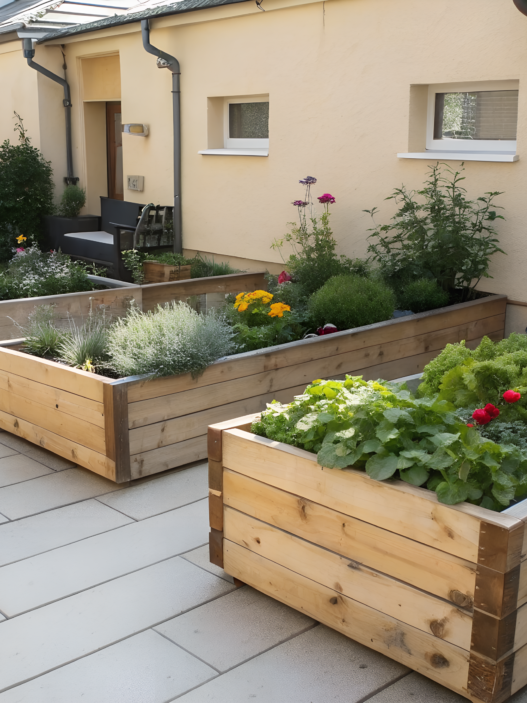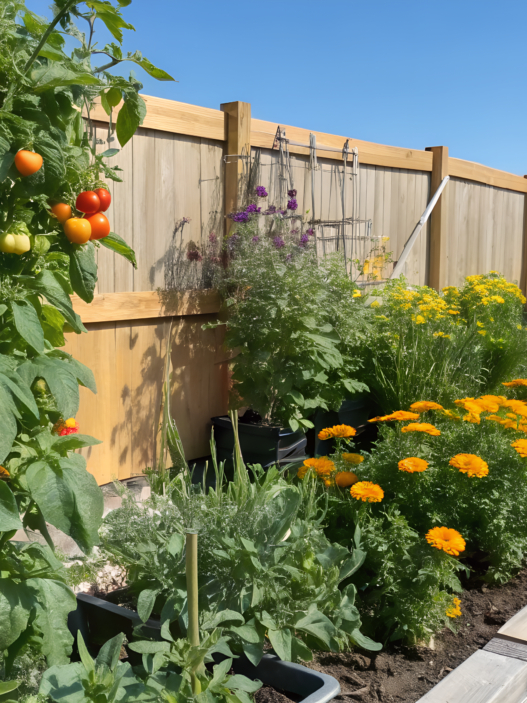Agreed, herbs are real magic, and not in a mystical sense, but in the most practical sense. They turn boring dishes into masterpieces, fill the house with freshness, and even help to fight colds, if you, of course, know about medicinal herbs.
But there’s one problem – not everyone has room for a big, beautiful garden. Some live in a small apartment, some live in a house without a garden, and some just don’t have free windowsills.
That’s why a DIY herb garden is a good option to solve the problem. Let’s approach the matter with imagination and analyze the most original and convenient ways of growing herbs – without a greenhouse and large costs.
DIY Hanging Herb Garden – The Game-Changer for Small Spaces

To be honest, space in the kitchen is always in short supply, it’s worth its weight in gold. If your windowsill is already crammed with everything you can get your hands on, then I recommend you try making a hanging garden.
Implementation options:
- Hang pots on a metal rod by the window.
- Attach a stylish wall-mounted planter (like this one on Amazon) to the wall.
- Use an old shoe organizer and plant herbs in the pockets.
Lifehack. Plants love fresh air, so leave space between pots to avoid mold. Do not forget about drainage! Water should not stagnate, otherwise the roots can rot. Use pots with holes or pour some expanded clay on the bottom.
Creative idea. Take an old wooden ladder, make holes in it and hang small metal pots on hooks. This is a vintage and practical design for herbs.
How to Build a Self-Watering Herb Garden – No More Daily Watering!

Yes, watering every day is not something everyone enjoys. It is for very busy people that self watering systems are simply a lifesaver.
How to make a simple self watering system:
- Take a deep container (such as a large pot or plastic box).
- Put a smaller pot inside with holes in the bottom.
- Pour water into the bottom of the larger container.
- Run a wick through the holes (e.g. from cotton rope or an old T-shirt), which will pull the moisture upwards.
This way, the soil itself will take as much water as it needs, and you won’t have to worry about daily watering. Convenient, isn’t it?
An additional idea. If you have several plants, create a single water reservoir (like a 5-liter bottle) and connect it to the pots with wick tubes.
The Secret to Growing Herbs in Tiny Apartments (Even Without Sunlight!)
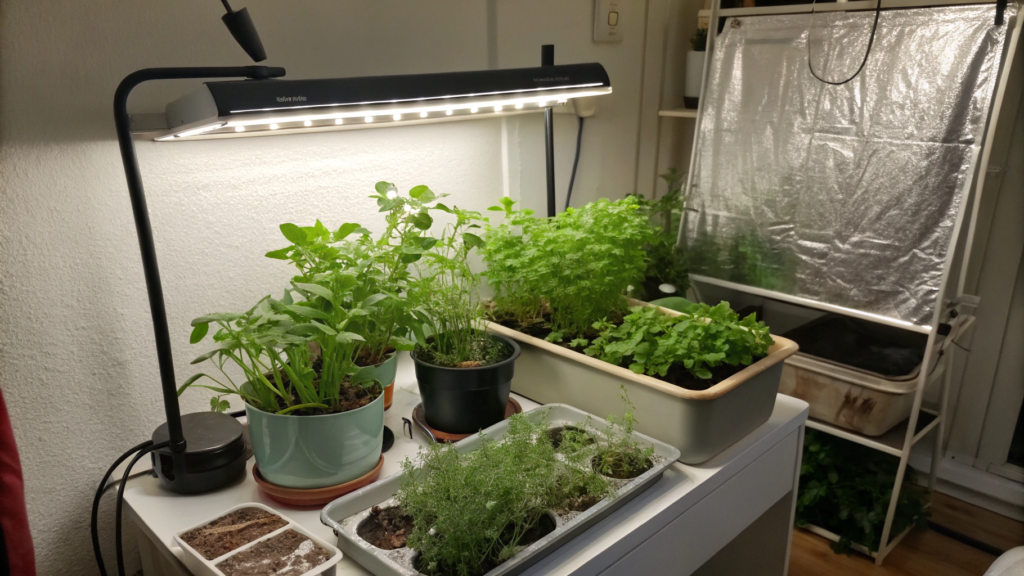
No balcony, no window – no problem. Because there are modern LED phytolamps, which will perfectly replace the sun. But if you want to do without them, there are a few tricks how to use even the minimum light to the maximum.
How to provide light for herbs in a dark room:
Phytolamps – these mimic sunlight and are perfect for herbs. For example, here’s this full spectrum lamp.
Mirrors and reflective panels – increase the amount of light available if there is little light in the room.
Choosing the right spot – even weak daylight can be enhanced by placing plants close to a window or a white wall that will reflect it.
The best herbs for low light are mint, parsley, chives and cilantro.
Tip. If your windowsill is poorly lit, place aluminum foil behind the herbs – it will reflect and amplify the light. And if the windows face north, place plants in the brightest place in the apartment – closer to the door or passage, where the natural light at least a little, but delayed.
DIY Mason Jar Herb Gardens – The Cutest Way to Grow Fresh Flavors

Mason Jars are not only stylish lemonade jars, nor are they great for mini herb gardens, especially if you’re short on space. You can arrange them on your kitchen windowsill, on a shelf, or even hang them on the wall with hooks and metal holders.
How to make your herb garden in a jar:
- Spread a layer of pebbles or expanded clay on the bottom (to keep the water from stagnating).
- Add activated charcoal (it prevents mold).
- Backfill with fertile soil and plant your favorite herbs.
What are the best herbs for jars?
- Basil – grows quickly and does well even in a small volume.
- Mint – unpretentious, but it is better to keep it separate so that it does not overgrow.
- Chives – compact, easy to trim and add freshness to dishes.
- Thyme – likes dry soil, so ideal for a small container.
Idea. Paint the jars with slate paint and sign the names of the herbs in chalk. It looks really cute.
Important point. The jars have no drainage holes, so be careful with watering. Tilt the jar slightly after watering to allow excess moisture to drain to the edges. This will reduce the risk of overwatering.
Upcycled Herb Gardens – The Unexpected Household Items You Can Use

You don’t have to buy expensive planters and planting boxes. You can make them out of old things. Upcycling is not only environmentally friendly, but also economical. They also look very stylish and unusual and add personality to the garden.
Unexpected things that can be used for planting herbs:
- Old tin cans – just make holes for drainage and you have a stylish mini garden ready. Paint the cans in pastel colors or wrap jute rope around them to make them look more attractive.
- A colander – it already has drainage holes, all that’s left is to pour in soil and plant herbs. This is a great option for growing basil, mint or thyme. Hang it on hooks by the window and you have an airy herb garden.
- Water trough – you can attach it horizontally to a wall, fence or balcony to create an unusual tiered bed. Great for chives, parsley and dill.
- Old wooden crates – these are great for creating a mini bed on a windowsill or balcony. If the box is deep, you can line the bottom with gravel for better drainage.
- Pull-out drawers from old furniture – give a vintage style and are suitable for large herbs such as lavender and rosemary. You can treat the wood with a water-resistant varnish to prolong its life.
Hint. if you want your upcycled garden to look even cooler, paint the containers, decorate them with rope or you can paint them with slate paint and write the names of the herbs in chalk.
DIY Herb Gardens That Grow Year-Round – Even in Cold Climates

If you live in a place where winters are very cold, that doesn’t mean you have to give up fresh herbs. There are several proven ways to grow herbs even when there’s snow and frost outside your window.
Three ways to grow herbs year round:
- Hydroponics is ideal for indoor winter growing. The plants get everything they need from a nutrient solution rather than soil. This eliminates problems with pests, dirt and complicated maintenance. I advise you to choose compact hydroponic systems with LED lighting that can be placed right in your kitchen.
- Mini greenhouses – can be made from a plastic container or old windows or even transparent fruit crates. Such structures create a greenhouse effect inside, protecting plants from frost and wind. Great for thyme, parsley and rosemary.
- Sill Gardens – Many herbs love the cooler temperatures and grow well in the house in winter. Laurel leaf, mint and basil will do well even on a cool window if they get enough light.
Lifehack. If the windows are old and let in the cold, put foam or insulation under the pots to keep the roots from freezing.
Tip. In winter, the air in the house often becomes too dry. Spray the herbs regularly with water to prevent them from drying out.
The Most Creative Herb Garden Beds You’ve Never Seen Before

We’re all used to the usual square or rectangular beds. But if you want something truly original, try some unconventional ways of planting herbs. These beds save space, beautify the plot and can even improve the growing conditions for plants.
Important! For all beds, you need to create good drainage by adding expanded clay, sand or a layer of crushed stone, especially in closed containers or blocks!
Cool ideas for unusual beds:
1. Spiral herb beds – an upward twisting bed creates different levels of moisture and microclimates. Plant dry-loving herbs (rosemary, lavender) at the top and moisture-loving herbs (mint, melissa) at the bottom.
- Use light, well-drained soil with sand for the upper levels and more nutritious soil with compost for the lower levels.
2. The beds made of concrete blocks – can be folded like a constructor, creating fanciful shapes. It is convenient to grow small herbs (thyme, oregano, basil) in the holes of the blocks.
- For beds you need a universal garden mixture with the addition of biohumus or compost for feeding.
3. Straw Bale beds – plants grow right inside straw bales! Over time, it turns into great compost, fertilizing the soil.
- In this case, the bales need to be well moistened and fertilized with compost tea before planting. A mixture of humus and garden soil can be added.
4. Vertical herb walls made from pallets – simply take an old wooden pallet, tilt it up against the wall and plant herbs between the slats. Great for mint varieties, parsley and chives.
- For this method, use a mixture of coconut substrate, peat and garden soil – it’s lightweight, won’t leach and retains moisture.
Additional idea. You can take an old wheel from a cart, divide it into sectors and plant it with different grasses. It will be both beautiful and convenient – different types of grass will grow in their own “section” without interfering with each other.
How to grow herbs if you have zero experience – step by step plan for beginners
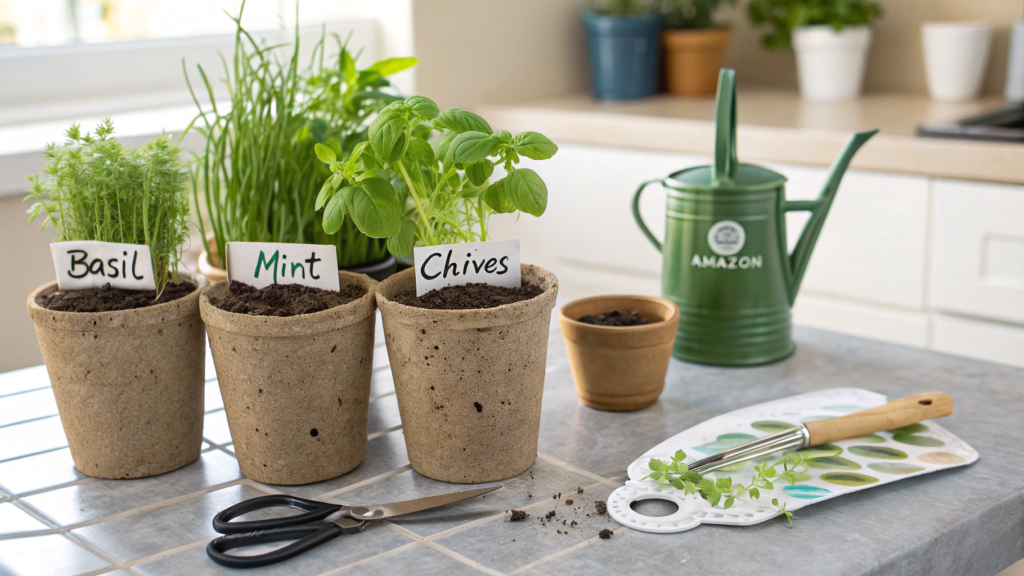
I believe that if you have zero experience in growing herbs, it’s a good thing. It means that there have been no mistakes yet and you can get it right right away.
Here’s a simple beginner’s scheme:
- Choose the 3 most unpretentious herbs: basil, mint and chives. They grow quickly, are easy to care for and produce a bumper crop.
- Find a sunny spot – herbs need at least 6 hours of light a day. If light is scarce, use phytolamps.
- Get pots with drainage holes – roots will rot in standing water! If there are no holes, pour a layer of pebbles on the bottom.
- Water properly – the soil should be moist, but not soggy. Check – if it’s dry at a depth of 2 cm, it’s time to water.
Useful tip. Cut the herbs more often. The more you cut, the faster they grow.
Ready-made starter kit. This kit on Amazon is perfect for beginners, with seeds, pots and fertilizer.
The Hidden Benefits of Growing a Medicinal Herb Garden at Home

We used to think that herbs were only for cooking. But in fact, many plants have medicinal properties, and if you grow them at home, you can always have natural remedies for headaches, colds, insomnia and stress on hand.
Which medicinal herbs are easy to grow at home?
- Peppermint – helps with digestive problems, headaches, and is also great for freshening breath.
- Lavender – calms nerves, improves sleep and helps with anxiety.
- Melissa medicinal is a natural remedy for stress and insomnia. Its tea is especially good before bedtime.
- Echinacea is one of the best natural remedies for strengthening immunity.
Tip. Dry grown herbs and make homemade herbal teas, oils or tinctures. It is natural, useful and many times cheaper than pharmacy analogs.
Scientific fact. Studies by the U.S. National Institutes of Health have proven that chamomile tea helps reduce anxiety and improves sleep.
How to Grow Herbs in 5-Gallon Buckets – The Easiest DIY Hack

Yes, exactly in buckets because they are cheap, convenient, easy to move around and suitable even for herbs with deep roots.
How to make an herb mini garden in a bucket:🌿
- Drill drainage holes in the bottom so there is no stagnant water.
- Fill the bottom with gravel or expanded clay, then add soil.
- Choose deep herbs: rosemary, lavender, lemongrass – they grow well in buckets.
- Place the bucket in a sunny spot and keep an eye on watering.
Lifehack. Attach wheels to the bucket to easily move it into the sun or shade. Or use a ready-made wheeled platform (such as a wheeled planter stand).
Additional idea. Insert a PVC pipe with small holes vertically inside the bucket. Water directly into the pipe – this will distribute the moisture evenly and the roots will receive water more deeply.
It’s time to roll up your sleeves!
Growing herbs doesn’t require a huge garden or specialized knowledge. Even if you have very little space, you can make a hanging mini garden, grow herbs in Mason Jars, or plant them in a bucket.
Which of these methods do you like best?
Write in the comments which DIY project you try first!
